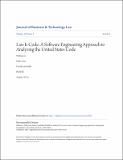Law Is Code: A Software Engineering Approach to Analyzing the United States Code
Author(s)
Li, William P.; Azar, Pablo Daniel; Larochelle, David; Hill, Phil; Lo, Andrew W.
DownloadLo_Law is code.pdf (3.006Mb)
PUBLISHER_POLICY
Publisher Policy
Article is made available in accordance with the publisher's policy and may be subject to US copyright law. Please refer to the publisher's site for terms of use.
Terms of use
Metadata
Show full item recordAbstract
The agglomeration of rules and regulations over time has produced a body of legal code that no single individual can fully comprehend. This complexity produces inefficiencies, makes the processes of understanding and changing the law difficult, and frustrates the fundamental principle that the law should provide fair notice to the governed. In this Article, we take a quantitative, unbiased, and software-engineering approach to analyze the evolution of the United States Code from 1926 to today. Software engineers frequently face the challenge of understanding and managing large, structured collections of instructions, directives, and conditional statements, and we adapt and apply their techniques to the U.S. Code over time. Our work produces insights into the structure of the U.S. Code as a whole, its strengths and vulnerabilities, and new ways of thinking about individual laws. For example, we identify the first appearance and spread of important terms in the U.S. Code like “whistleblower” and “privacy.” We also analyze and visualize the network structure of certain substantial reforms, including the Patient Protection and Affordable Care Act and the Dodd-Frank Wall Street Reform and Consumer Protection Act, and show how the interconnections of references can increase complexity and create the potential for unintended consequences. Our work is a timely illustration of computational approaches to law as the legal profession embraces technology for scholarship in order to increase efficiency and to improve
access to justice.
Date issued
2015Department
Massachusetts Institute of Technology. Computer Science and Artificial Intelligence Laboratory; Massachusetts Institute of Technology. Department of Economics; Massachusetts Institute of Technology. Department of Electrical Engineering and Computer Science; Sloan School of ManagementJournal
Journal of Business & Technology Law
Publisher
University of Maryland School of Law
Citation
Li, William, Pablo Azar, David Larochelle, Phil Hill, and Andrew W. Lo. "Law Is Code: A Software Engineering Approach to Analyzing the United States Code." Journal of Business & Technology Law 10(2) (2015).
Version: Final published version
ISSN
1941-5788